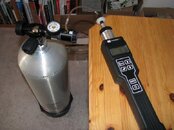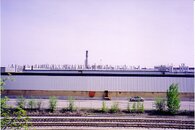Activated charcoal, or activated carbon on a Rix is a waste of time and frankly a risk and it reduces performance duration.
If a catalytic converter CO removing chemical is needed its when using a petrol or gas engine drive and for that we
recommend an additional 10" tower of the same 3.75" diameter filled purely with Hopkalite downstream at the
dry end, with a filter change every two years or 1000 hours.
IMHO Don't mix Hopkalite with AC and MS in the same tower, its a cheap trick, it is a waste of money and
adds risk even more so on a conventional oil lubricated compressor.
Iain I hesitated in recommending an AC bed on a Rix however one really needs to look at what is in the proximity of the compressor intake and even what neighbours and roadways are near the intake. Recall that for any VOC in the air the surface effective concentration is multiplied by the absolute pressure at depth.
I have a friend who is one of your friendly tech divers and who purchased a Rix in order to reduce the risk of VOC exposure coming off the oil-lubed compressor. One day he told me a story that changed my opinion on not using an AC bed on a Rix for diving applications. As you suggested he only had a 28 inch column of MS 13x and kept his air bone dry given he often dives when there is snow and ice on the shore. During this one summer he called me up to come and smell his tank air which he thought smelled like tar. The compressor was at his workplace in an industrial strip mall and the intake drew from an outdoor vertical wall at the back of the wood working shop where normally he had no odoriferous neighbours or so he thought .
I arrived the next day and instead of going to the front door I went to the back door where the compressor inlet was located and about 200 metres upwind quite out of view was a roofing company's black tar heater spewing fumes into the local ambient air. When the compressor was started the day before these guys were not there but clearly they arrived and the diver had not noticed their presence during the fill.
We also know that if one's intake is located within a few hundred metres of a freeway or certain industrial plants that VOC concentrations (i.e. BTEX) can be quite high and while not a problem at 1 atmosphere if diving trimix at 12 ATM they could very well become an issue.
Even in the rural areas with farms and manure spreading there are lots of VOCs that you don't want in your tank. And when I hear the word garage I expect the worst as most people's garages are full of VOCs from paints, glues, engine cleaner, etc which can get accidentally sucked into the intake.
So yes it is a bit of a judgement call and if one was very sure that the neighbours were not going to contaminate the intake air I'd could see forgoing the AC bed. A small AC bed is inexpensive and if it is kept dry with a visual humidity intake there is no risk of water displacing the stored VOCs especially if it is just ambient VOCs (oil lubed compressors is different story) being stored between cartridge changes.
There is a way to check one's breathing gas prior to jumping in for that 12 ATM dive and that is to use a portable photoionization detector (PID) as seen below. They are finicky to use and not cheap but it can be done if all you have is a oil-lubed compressor but you want to make sure your breathing gas is VOC-free air. I know the military has experimented with using such devices in the field as well.
As for whether or not to add a Hopcalite bed (the name Hopcalite comes from the inventors who were at John's Hopkins university and University of California) again it really depends on the risk of an unexpected external CO contamination incident. I do think your idea of having a separate CO tower and bed is a good one but clearly adds to the upfront expense. For most it is just easier to pay the extra $5 per cartridge and throw it out with the MS and AC. Not that environmentally friendly for sure.
The story that was told here on Scubaboard by Rjack I believe is a good example of why one might want to have a catalyst bed on a Rix compressor in an urban environment. I can't recall if he did have a catalyst bed or not, but he did have a portable CO detector with 95 dB alarm set to go off if the CO concentration on the discharge was > 10 ppm. One day he was filling his tanks in his garage and the alarm went off. When he went out to investigate either his wife or neighbour was running the petrol-powered lawn mower near the intake.
Again it might be just simpler to forgo the catalyst bed and purchase a ToxiRae 3 or Oxycheq CO monitor and plumb that into the discharge air. They will alarm if you are nearby should there be an unexpected lawn mower nearby.
I'm curious if your BS8476 and the Euro breathing air standard EN12021 both require compressed air > 200 bar to have a maximum moisture content of 25 mg/m3 (-52 C atmospheric dew point) then every Rix you sell must be sold with an filter tower packed with molecular sieve in order to meet that standard over there.

What is odd over here in the US and Canada is that for hospitals now the compressed air used on patients at one atmosphere must be produced using an oil-less or oil-free compressor, but in both countries for the hyperbaric chambers in those same hospitals the compressed air used up to 6 ATA can come from an oil-lubed compressor. I think they have it backwards.
In an ideal diving world we would all be using a Rix oil-less compressor.
Thanks Mani







